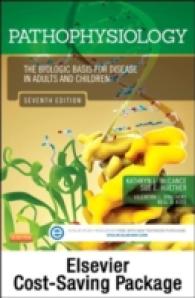- ホーム
- > 洋書
- > 英文書
- > Science / Mathematics
Full Description
This book covers the various sources, the role of treatment technologies, system-associated factors, and future challenges with reference to microplastics in wastewater treatment plants. It also introduces microplastics, their sources, governing factors, microbial diversity effects, and possible control approaches to minimize the exposure of microplastics to human beings. Modelling and distribution of microplastics, environmental sinks, bioindicators, and microplastics as vector in wastewater treatment units are also discussed.
Focuses on microplastic pollution, mechanism of removal, treatment technologies, pathways, and fate in wastewater treatment system
Discusses the factors linked to dispersion, survival, and removal efficiency of microplastics in wastewater treatment systems
Helps understand 'microplastics removal'-centric sustainability aspects of wastewater treatment systems
Explores the fate of microplastics in sludge-handling systems
Incorporates comparative case studies from developed and developing nations
This book is aimed at graduate students and researchers in environmental science and engineering, water resources management, wastewater, and chemical engineering.
Contents
1. Examining the Presence of Microplastics in Wastewater: A Bibliometric Analysis and Overview. 2. Characterization Techniques for Quantifying Environmental Microplastics. 3. Plastic Peril: Unraveling Microplastics Threats to Health and Ecosystems. 4. Bioindicators of Microplastics. 5. Role Of Various Microbes and Their Enzymatic Mechanisms for Biodegradation of Microplastics. 6. Microplastics in Aquaculture: Implication on Fish and Human Health. 7. Investigating Approaches and Technologies for Microplastics in Wastewater Management. 8. Characterization and Removal of Microplastics in Different Stages of Wastewater Treatment Plants. 9. Environmental Sink of Microplastics Associated with Wastewater Treatment and Allied Processes. 10. Mass Balances and Life Cycle of Microplastics Across Wastewater Treatment Plant: A Process Review. 11. Wastewater Treatment Plants as a Key Source of Secondary Microplastic in the Urban Environment: A Case Study from Uttarakhand, India. 12. Distribution of Microplastic in Egypt Wastewater Using Aquatic Insects as Bioindicators. 13. Recent Trends in Microplastic Detection based on Machine Learning and Artificial Intelligence. 14. Artificial Intelligence and Machine Learning Approaches for Automatic Microplastics Identification and Characterization.








